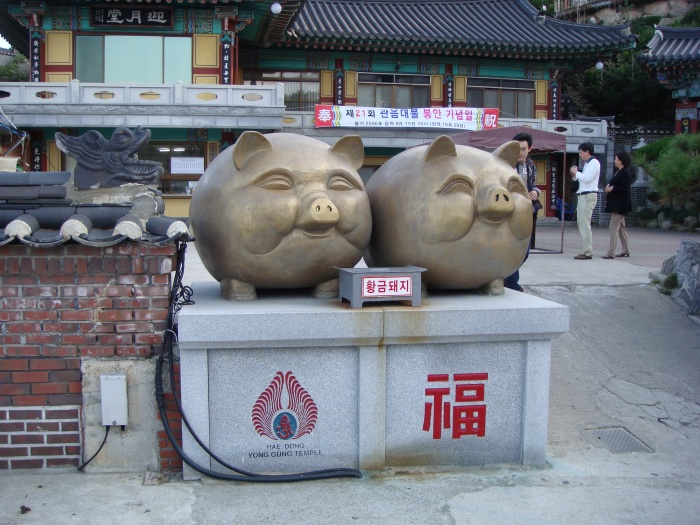South Korea’s southernmost temple spreads across rocky outcrops in the Sea of Japan like a spider delicately perched on strands of its web. Built in 1376 it has survived suppression by Confucianism and outright destruction by the Japanese, and remains an important centre of Korean Buddhism to this day.
The approach is lined with statues, pagodas, restaurants and gift shops. This is a tremendously popular destination with tourists and locals alike, and unless you come early in the day you are most likely going to be surrounded by your fellow visitors. The first real sign that you are past the restaurants is this row of the Twelve Spirit Generals.
The site was reconstructed in the 1970’s, so a great deal of what you will see are reproductions and modern creations, which lends the temple that slightly-fake feel of many of the region’s temples.
Remember these stairs: you’re going to be climbing them on the way out.
There are plenty of places to drop a few coins and wish for luck. This collection of Buddhas is halfway down the stone staircase that descends the mainland cliff and leads to the bridge over to the temple itself.
Once you are most of the way down the stairs there is a little pathway to your left. It leads to a teahouse, but also an excellent place from which to view the temple itself, leading to what must be the most-snapped shot in the entire area.
There is a buddha on this outcrop, his back to the sea.
It also leads to this charming little bridge, which offers a path up to the neighbouring agricultural institute.
Across the bridge is the temple itself, along with yet more places to eat.
In the centre of the temple’s open plaza is a mysterious set of steps leading down into the darkness. Have no fear, it’s entirely all right for you to head down here, and it leads to a little cave in which there is a small spring of pure water. The spring is highly prized; candles are lit in the darkness, and prayers are spoken.
One of the temple’s big draws is this pair of gold-coloured pigs. People make a wish, rub the pigs’ foreheads, and drop a coin into the votive box. You’ll also find tourists standing behind them and hugging them for photographs.
From the bridge there are lovely views out toward the sea.
Alas it soon becomes clear that visitors cannot refrain from scribbling on the sights, or throwing their rubbish into the water. Stupas are covered in graffiti, and the waters and rocks below the bridge are smothered in cans, plastic, and other litter.
Buddha himself is as chipper as ever, though.
And dotted around the site are genuinely charming nooks and crannies. Don’t be afraid to wander away from the crowd to find them.
Visiting Haedong Yonggungsa:
Take Subway Line 2 to Haeundae station, and use exit 7. The bus stop is within 10 meters of the exit. Take bus 181 and get off at Haedong Yonggungsa approximately 30 minutes later. The temple is up a steep hill – follow the road and you will reach it after about 10 minutes. You must listen for your stop or check with the bus driver – it is not obvious from the road that this is the correct stop.
Admission: Free.















One of my favorite places in Busan!
Mine too. I really enjoyed it.